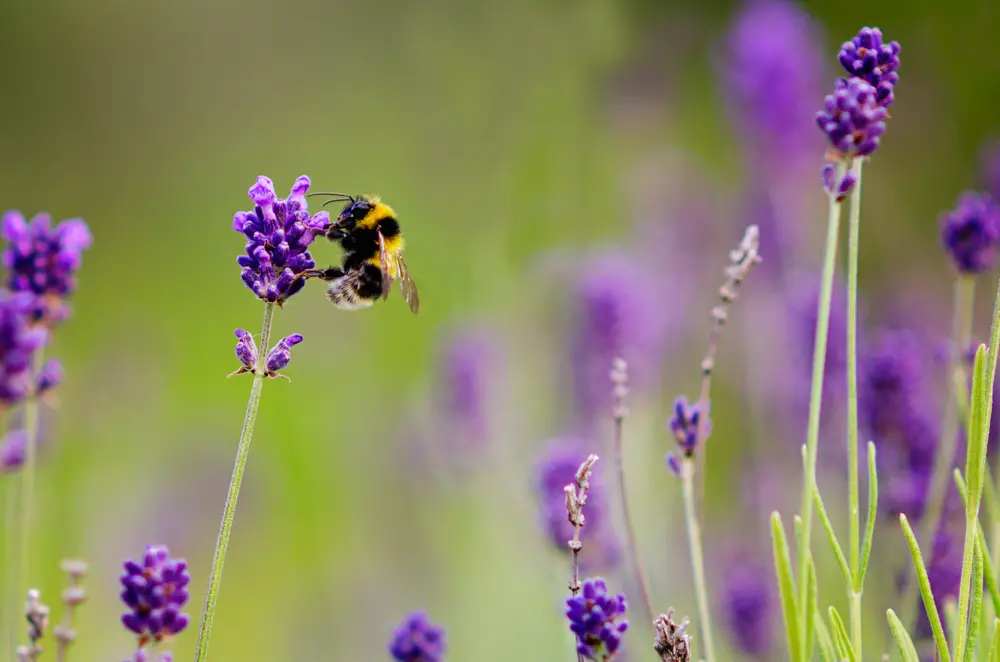For the last couple of years, I’ve been trying to attract more pollinators to my garden, particularly bees. In fact, it’s great to do so. So, what are the best ways to attract bees to your garden?
The six best ways to attract bees to your garden are:
- Plant native plants
- Let some of your lawn grow wild
- Provide them with water
- Avoid using pesticides
- Create nesting spots
- Consider buying a hive
Why Should You Attract Bees To Your Garden?
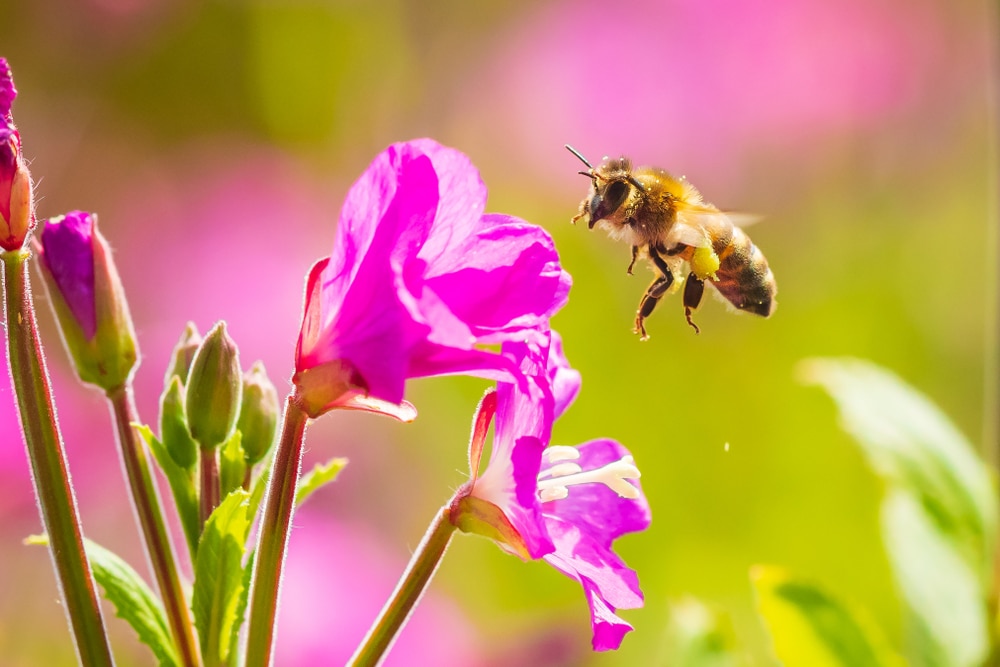
I’ve spoken to many people who, sadly, aren’t aware of the importance of bees. Not that I blame them; there’s simply not enough awareness of the topic. But I want to change that because I’m so passionate about these amazing insects.
Bees are pollinators. This means that they transfer pollen between plants of the same species, which results in pollination (the starting point for plant reproduction.) Without bees, many crops and flowering plant species would struggle to survive.
In fact, did you know that as many as 75% of all human crops rely on bees for pollination?
So, what does that mean for your garden? Well, for starters, you’re replacing critical lost natural habitats for these creatures by creating a bee-friendly garden. This will directly impact local crop production simply because more habitat equals more bees.
But the effects of attracting bees to your garden can also be much closer to home. For example, if you grow flowering plants or even your own fruit and vegetables, these pollinators will get to work right there in your backyard.
I also cannot stress enough the wonder of bees and how amazing they are to watch. I’ve spent many a content afternoon watching our winged friends buzzing around my backyard, and there’s a real satisfaction in doing so.
If you’re someone who wants to help local wildlife and have the opportunity to get up close and personal with it, I’d highly recommend trying to attract bees to your garden.
How Hard Is It To Attract Bees To Your Garden?
If you’ve never noticed bees in your garden before, then you might think it’s an impossible task. But in most cases, a lack of bees simply results from not having a suitable environment for them.
Later in this guide, I will delve into some tips you can follow to attract bees to your garden. What you’ll notice is they’re all things you can do without having to make any major changes.
Moreover, attracting bees to your garden isn’t expensive and primarily involves adjusting your existing garden. The only thing that might come with a cost is the purchase of native plants, but plenty of garden stores offer these for a reasonable price.
Actually implementing the tips I’m going to talk about doesn’t take much effort at all, either. In fact, you can do most things in the space of a free Saturday afternoon. So, why not give it a go?
When Will You Start To See Results?
Pollinators, like bees, are everywhere. But if you haven’t created a suitable habitat for them, they just won’t show up. However, once you develop your bee-friendly garden, it won’t take long before you notice many tiny visitors.
Personally, I found it took a couple of weeks to see a noticeable difference in the number of bees turning up. Now, a couple of years later, I have regular bees stopping by to check out my garden.
But don’t worry. You’re not going to be overwhelmed by bees. For me, a steady stream comes and goes, and they don’t cause me any problems.
Of course, the more you develop the habitat you create, the more likely you are to see bees more quickly. It is possible to dedicate a tiny area of your garden to bees, but in this case, they’re less likely to find it as quickly as if you turn your whole backyard into a bee haven.
In any case, anything you can do to provide food, nesting spots, and safety for these creatures is amazing, and you will eventually start to see results.
The 6 Best Ways To Attract Bees To Your Garden

The beautiful thing about creating a bee-friendly garden is that you can do so many simple things. If you’re looking to attract bees, then the following steps are almost guaranteed to produce results.
Let’s start with planting native plants.
1 – Plant Native Plants
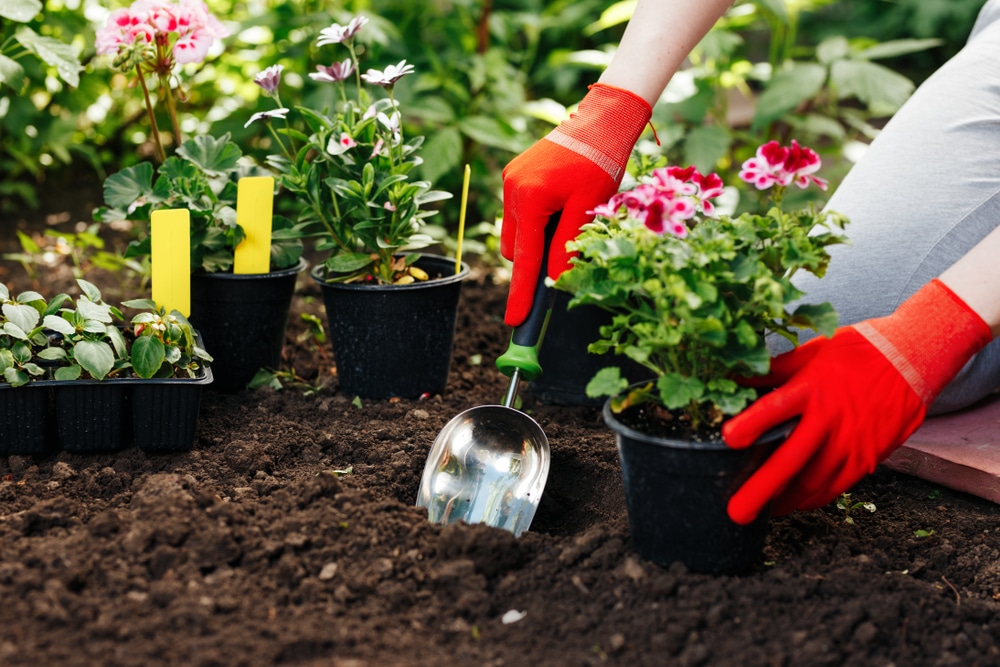
When I talk to people about attracting bees to their gardens, one of the first things I always tell them is to plant native plants, which are plants native to an area. They can naturally thrive in local conditions.
On the other hand, exotic plants have been taken from other climates and environments for gardeners to grow. While many people succeed with exotic plants, they’re not naturally compatible with local conditions.
Bees (and other local pollinators) prefer native plants. That’s not to say they won’t interact with exotic species, but you’ll have far more success by planting native species.
Moreover, native plants are going to have the best chance of thriving. These species are adapted to local conditions and generally turn out to be healthier and stronger than their exotic counterparts. This means more pollen and nectar for the bees.
Remember To Group Your Plants
There is nothing wrong with having diverse flowering plants in your garden. In fact, this is a great way to attract bees. However, it’s no good planting them randomly, as this doesn’t work with the behavior of bees.
We know that a bee will focus on one type of flower during any given foraging flight. This is known as flower constancy. So, if you’ve got lots of different species mixed together, this will make life more difficult for the bees, and they’ll likely bypass them altogether.
It’s much better to plant patches of flowering plants of the same species. Experts recommend choosing an area of around 3 ft x 3 ft and only planting one type of flower. You can find this information in a handy book called The Little Book Of Bees by Hilary Kearney.
Have Flowers For All Seasons
Bees are attracted to a whole bunch of flowers, so you’ve got many options when choosing which flowers you’d like.
But I suggest opting for plants that flower at different times of the year. For example, in the very early months, things like snowdrops and crocus begin to bloom, while plants such as lavender, borage, and marjoram flower in the summer.
Bees are typically active from spring when the weather starts to warm up, and remain active until the late summer or early fall. When they begin to hide away will depend on the local climate, as their activity largely relies on temperature. Once the temperature dips below 50ºF (10ºC), you’ll see less of them.
However, during their active period, having a wide range of plants flowering at different times will always ensure a reliable food source.
2 – Let Some Of Your Lawn Grow Wild
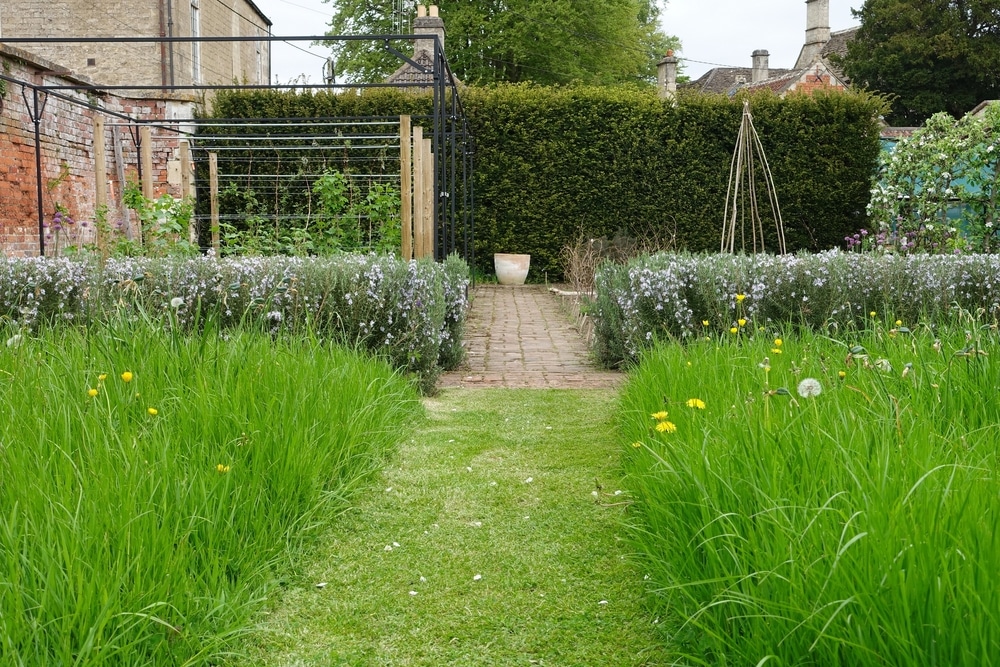
One of the first things I did to attract bees to my garden was to allow a patch of my lawn grow wild. When I suggested this idea to my friends and family, they immediately responded, “It’s going to look awful!” But it doesn’t!
I chose a 10 ft strip of lawn along one of the fences in my backyard (it’s also around 3 ft in width). Because the grass is growing along a fence, it creates a wild border, and the number of pollinators I’ve noticed in the area is astonishing.
By letting even a small patch of lawn grow longer, you’ll encourage the growth of wildflowers. You can even buy wildflower seed packets to use in this area. The result is a natural habitat where bees (and other pollinators) have food and shelter.
One thing is to check your local laws on grass length. There may be some areas where you’re permitted to grow your grass only to a certain height. While helping bees is essential, you don’t want to risk a fine in the process.
3 – Provide Water

Providing a water source is one of the easiest things you can do to attract bees to your garden. I once read that even something as seemingly irrelevant as a dripping hose can attract bees.
Of course, you can go much bigger and consider installing a wildlife pond. This will be a more expensive venture, but it also adds a beautiful focal point to your garden and will attract a whole host of wildlife, including bees and other insects, frogs, birds, and many more.
Just remember to include rocks and other stable surfaces bees can stand on. They’re not good swimmers and need a shallow surface to stand on.
For most people, however, something like a bowl of water is more than enough. You can place this discreetly, but remember to add some rocks for the bees to land on.
Bees drink water, but they’ll also collect it and take it back to the nest for temperature regulation.
4 – Avoid Using Pesticides
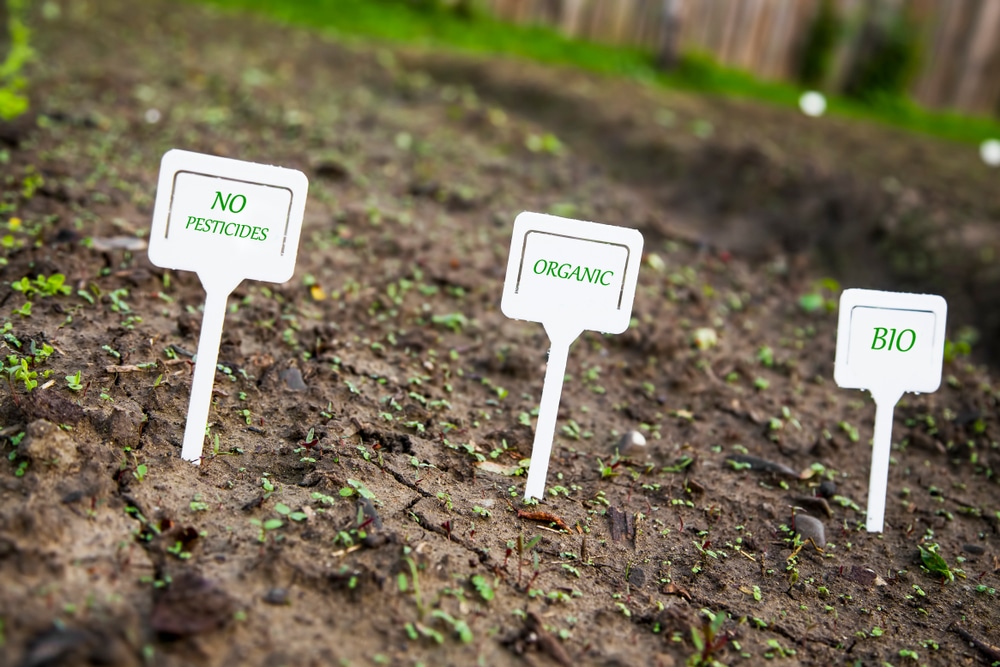
One of the worst things you can do for bees is use pesticides (and other garden chemicals). The whole point of these products is to deter and harm insects, and while most pesticides won’t kill bees, they can do much worse long-term damage.
For example, garden pesticides can affect the memory and learning of bee larvae. When bees collect pollen from contaminated plants, they take this back to the nest and feed it to their young. What’s more, other studies have shown pesticides can affect the memory of worker bees, which then don’t as easily remember rewarding scents.
If that wasn’t enough, the use of pesticides around bees causes damage to their reproductive abilities and their immune systems.
Now, I realize there are probably many pests in your garden you want to get rid of, but using organic methods is much better.
For example, if you find pests like scale bugs and aphids on your plants, you could hand-pick them off or wash them away with a hose. Alternatively, you might introduce natural predators like ladybugs and lacewings, which will more than efficiently solve the problem.
For ground pests like slugs and snails, it’s a case of making it impossible to get near your plants. Many people successfully sprinkle broken eggshells around their plants, which are extremely difficult and uncomfortable for these pests to crawl over.
5 – Create Nesting Spots
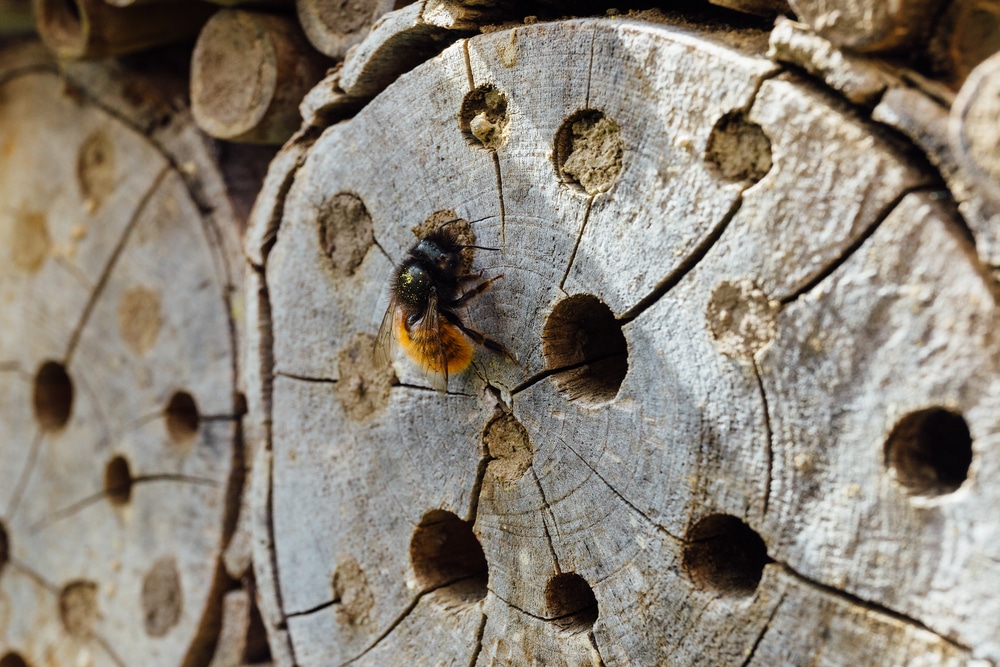
Bees nest in several different ways. There are ground nesters, such as the bumblebee, and cavity nesters, like the carpenter bee. Honey bees, as you may know, often live in humanmade hives, but in the wild, they make nests in trees or rock crevices using wax.
In any case, if you’re looking to attract bees to your garden, you need to make viable nesting spots, which you can do in one of two ways.
Natural Nesting Spots
Leaving a log or grass pile is a great way to provide natural nesting spots for bees. I have a small corner of my garden where I dump all my grass clippings, and this serves as a fantastic area for bees to nest and take shelter.
Since some bees nest in the ground, it’s vital for you to allow them this opportunity by leaving some bare patches of soil. Bumblebees will tunnel a small hole into the ground, around the thickness of a pencil, but it’s not as easy for them when they have to tackle grass, weeds, and plants.
Bee Hotels
A bee hotel is an excellent human-made nesting spot for many solitary bee species. You can buy these on Amazon or other online stores, which are relatively inexpensive. They’re fitted with tubes of various sizes for the bees to enter and lay their eggs.
What’s great is you can even make your own bee hotel using hollow rods and canes arranged in a wooden house-like structure. I think this is a wonderful project to do with the kids if you want to teach them about the value of nature.
6 – Consider Buying A Hive
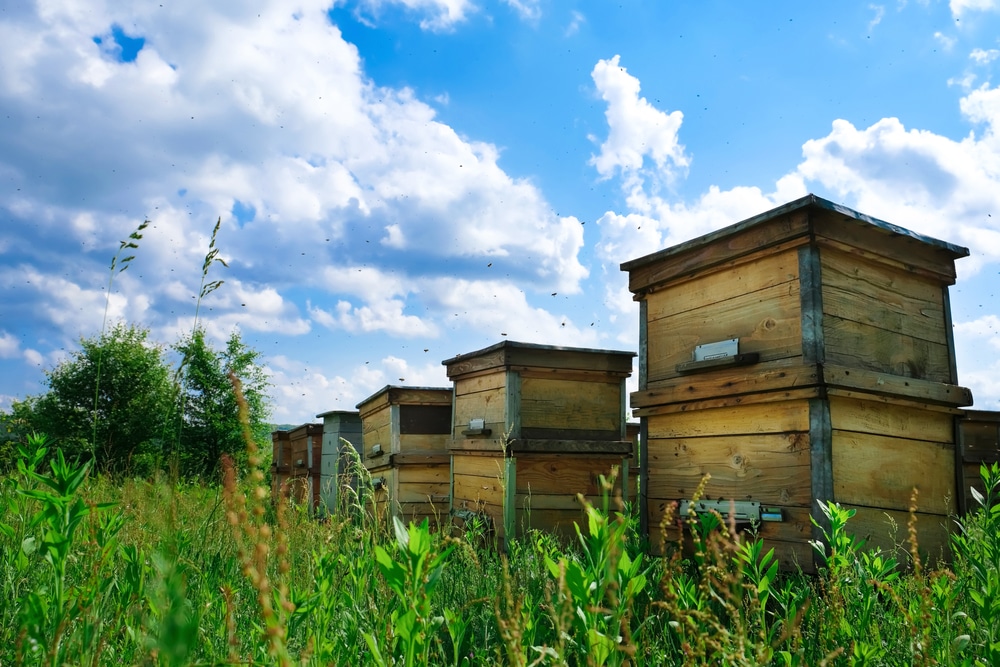
I have been considering buying a beehive for some time now. I’ll admit I still haven’t decided, but I’m strongly leaning toward becoming a beekeeper.
This isn’t something you should take on if you’re not prepared to put in the time, effort, and investment, though. But the good news is that getting started with beekeeping isn’t hugely expensive.
A beehive costs between $150 and $200 on average (and there are additional costs for gear, supplies, etc.), but you have to consider that, once established, you can make a supplementary income selling honey, wax, and other bee products (just don’t forget to leave enough honey for the bees!)
Again, I would strongly consider your options here, as beekeeping isn’t for everyone. It’s not a hobby that will take up immense amounts of your time, but a degree of work is involved. Generally speaking, you’ll need to dedicate up to 30 hours a year, which doesn’t sound like a lot, but with the busy modern lifestyle, you need to make sure you can fit it in.
If, after considering the above points, you want to go ahead and purchase your very own hive, then that’s great! You’ll not only have a consistent bee presence in your garden, but you’ll be strongly rewarded, and you’ll be doing your bit for the local ecosystem.
Is It Safe To Have Bees In My Garden?
I often get asked whether it’s safe to have bees in your garden. The short answer is yes!
Most bees (excluding one species called the Africanized honey bee) are incredibly docile creatures. They only show aggression when they feel threatened. In that case, some species may sting.
However, if you allow bees their space and let them get on with their foraging, they won’t cause you any problems. You may want to observe them, but do this from a distance that isn’t going to make them feel as though they’re in danger.
With that said, while I love having bees in my garden, I don’t want them buzzing around when I’m having a BBQ. In this case, keeping food and drink covered is essential so you don’t attract their attention to the wrong areas.
In addition, if you suspect you have or do have a bee allergy, you’ll want to talk with your doctor about staying safe.
Will Attracting Bees Attract Anything You Don’t Want?
One of the insects most people don’t want to attract is the wasp. These are often aggressive and can be a nuisance when trying to enjoy outdoor dining.
However, while they may be attracted to some of the things you’ve put in place for bees, choosing your plants wisely will help to keep them away. Wasps are more attracted to white and yellow flowers, whereas bees prefer those on the blue/purple spectrum.
Generally speaking, your bee-friendly garden will attract many other creatures, but most will be beneficial. You may notice an increase in the number of butterflies and moths, and if you live in an area where they’re found, hummingbirds may also come to check out your pollen plants.

